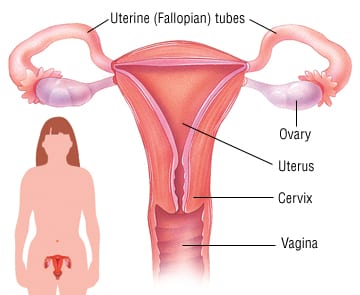输卵管癌
What is Fallopian Tube Cancer?
Fallopian tube cancer, also referred to as tubal cancer, emerges within the fallopian tubes, which serve as the connecting pathway between the ovaries and the uterus. This type of cancer is exceptionally uncommon, accounting for only 1 to 2 percent of all gynecologic cancers. Globally, there have been reports of 1,500 to 2,000 cases of fallopian tube cancer. In the United States, approximately 300 to 400 women are diagnosed with this condition each year.
Interestingly, cancer more frequently originates from other parts of the body, like the ovaries or endometrium, and then spreads to the fallopian tubes rather than having its primary origin in the fallopian tubes themselves.
The typical age range of women affected by fallopian tube cancer is between 50 and 60, although it can develop at any age. Caucasians, particularly those who have had few or no children, are more prone to this type of cancer.
Due to its rarity, limited knowledge exists regarding the specific causes of fallopian tube cancer. However, researchers are exploring the potential role of genetics in its development. Some evidence suggests that women who have inherited the BRCA1 gene, which is associated with breast and ovarian cancer, may have an increased risk of developing fallopian tube cancer.
Recent findings have led doctors to consider that many high-grade serous type epithelial ovarian cancers, which are among the most common ovarian cancers, might actually initiate in the distal end of the fallopian tube, rather than on the surface of the ovary.

Types of Fallopian Tube Cancer
Fallopian tube cancers mainly consist of epithelial or surface carcinomas, which implies that they originate from the tissue lining or covering the fallopian tubes.
There are various types of fallopian tube cancers, including:
- Papillary serous adenocarcinomas: This type accounts for more than 95 percent of all fallopian tube cancers. It arises from the cells that line the fallopian tubes. As these cells undergo abnormal division and invade other organs or spread to different parts of the body, tumors can develop.
- Primary fallopian tube cancer: Primary fallopian tube cancer is an exceptionally rare form, making up about 1 percent of all gynecologic cancers.
- Sarcomas (leiomyosarcomas): In some cases, tumors called sarcomas (leiomyosarcomas) may originate from the smooth muscle within the fallopian tubes.
- Transitional cell carcinomas: Tumors can also form on the other cells that line the fallopian tubes, known as transitional cell carcinomas.
Symptoms of Fallopian Tube Cancer
Detecting fallopian tube cancer can be challenging as its symptoms often overlap with those of various common conditions experienced during menopause, which is a time when this type of cancer commonly occurs.
Symptoms may include:
- Abdominal swelling
- Abdominal and back pain
- Loss of appetite or feeling full quickly
- Frequent or urgent need to urinate, along with changes in toilet patterns, such as alterations in bowel habits
- Unexplained weight loss or gain
- 消化不良或胃灼热
- 疲劳
- Watery discharge from the vagina.
If you experience any of these symptoms, it’s essential to consult your doctor. While these signs could be attributed to causes other than cancer, seeking medical advice is the only way to determine the underlying cause accurately.
Causes of Fallopian Tube Cancer
The specific cause of fallopian tube cancer remains unknown; however, certain factors are suspected to increase the risk, including:
- Advancing age (most cases are diagnosed in women between 50 and 60 years old).
- Post-menopausal status.
- Nulliparity (having no children).
- Family history of ovarian or breast cancer, particularly among close relatives (mother, sister, daughter).
- Increased risk associated with inherited mutations in the BRCA gene, which are linked to higher incidences of ovarian and breast cancers.
- Never having breastfed a child.
- Never having used birth control pills.
- Presence of endometriosis, a benign (non-cancerous) condition that can elevate the risk of ovarian and fallopian tube cancers.
Lower Your Chance of Getting Fallopian Tube Cancer
Various factors contribute to different types of cancer, and researchers are actively investigating the causes and prevention of ovarian and fallopian tube cancer. While there is no definitive way to completely prevent these cancers, it may be possible to lower one’s risk. Consulting your healthcare team can provide valuable insights into your individual cancer risk.
Studies have indicated that certain factors may reduce the risk of developing ovarian and fallopian tube cancer:
- Taking birth control pills: Individuals who have used oral contraceptives for three or more years have shown a 30% to 50% lower likelihood of developing ovarian and fallopian tube cancer. This decreased risk might persist for up to 30 years after discontinuing the pills. Additionally, intrauterine devices (IUDs) have been associated with a reduced risk of ovarian cancer.
- Breastfeeding: Prolonged breastfeeding after childbirth is linked to a decreased risk of ovarian and fallopian tube cancer.
- Pregnancy: The number of full-term pregnancies a person has experienced is inversely related to their risk of ovarian and fallopian tube cancer.
- Surgical procedures: People who have undergone a hysterectomy or tubal ligation tend to have a lower risk of developing ovarian and fallopian tube cancer. A hysterectomy involves removing the uterus and sometimes the cervix. Tubal ligation is a surgical procedure where the fallopian tubes are tied or closed to prevent pregnancy. For individuals at high risk of ovarian and fallopian tube cancer, doctors might recommend bilateral salpingo-oophorectomy, which involves removing both ovaries and fallopian tubes. Some individuals choose to have their fallopian tubes removed during abdominal surgery for other purposes or during a caesarean section after completing their desired number of childbirths.
- High-risk genetic mutations: Individuals with genetic mutations like BRCA1, BRCA2, and genes associated with Lynch syndrome are advised to consider removing their ovaries and fallopian tubes after completing childbearing. This preventive measure can reduce the risk of ovarian and fallopian tube cancers by up to 96%. Furthermore, if the surgery is performed before natural menopause, there may be a 40% to 70% decrease in the risk of developing breast cancer, especially for individuals with BRCA2 mutations.
Detection of Fallopian Tube Cancer
Due to the rarity of fallopian tube cancer and its symptoms resembling other conditions, diagnosing it can be challenging. Sometimes, women only discover they have fallopian tube cancer when a tube is surgically removed during treatment for another health issue.
However, several tests can aid in definitively diagnosing the condition. Your doctor will begin by inquiring about any symptoms you may be experiencing, reviewing your medical history, and conducting a thorough physical examination. Additional tests that may be performed include:
- Pelvic Exam: This involves the examination of the uterus, vagina, ovaries, fallopian tubes, bladder, and rectum to detect any abnormalities in size or shape.
- CA125 Test: A blood test to measure CA125 levels, a tumor marker associated with gynecological diseases, including fallopian tube cancer. While approximately 85 percent of women with gynecological diseases have elevated CA125 levels, it’s crucial to note that increased CA125 levels may not necessarily indicate cancer. Levels can also rise during pregnancy, menstruation, and other non-cancerous gynecological diseases or cancers affecting different parts of the body.
- Computed Tomography (CT) Scan: This imaging test captures detailed pictures of the body’s internal areas. A computer, linked to an X-ray machine, generates these images. To enhance organ or tissue visibility, a special dye may be injected into a vein or swallowed.
- Ultrasound: Pelvic ultrasound uses high-frequency sound waves to create images of organs and systems within the body. These sound waves, inaudible to humans, produce a pattern of echoes called a sonogram, which can differentiate between healthy tissues, fluid-filled cysts, and tumors.
- PET (Positron Emission Tomography): PET scans involve the use of a radioactive sugar (glucose) to identify cancer cells. This test is sometimes employed to detect the spread of fallopian tube cancer.
These tests collectively aid in achieving an accurate diagnosis and better understanding the extent of fallopian tube cancer if present.
Stages of Fallopian Tube Cancer
The stages of fallopian tube cancer are determined by the extent of its spread, ranging from the earliest (Stage I) to the most advanced (Stage IV):
- Stage I: Cancer is confined to one or both fallopian tubes.
- Stage II: Cancer has extended to the uterus or nearby tissues within the pelvic region (which includes internal reproductive organs, bladder, and rectum), or it is localized on the peritoneum.
- Stage III: Cancer has progressed beyond the pelvic region and spread to lymph nodes and/or other abdominal areas (such as the surface of the liver or spleen).
- Stage IV: Cancer has metastasized to distant locations, such as the lungs.
Treatment of Fallopian Tube Cancer
The treatment choices for fallopian tube cancer are contingent on the type, stage, and location of the cancer, along with your overall health and personal preferences.
Surgery
Surgery plays a crucial role in the treatment of ovarian and fallopian tube cancers, and it is typically carried out by a gynecologic oncologist, a specialist in treating gynecologic cancers, including surgical procedures and chemotherapy (see “Chemotherapy” below).
As mentioned earlier in the Diagnosis section, surgery is often necessary to fully assess the extent of the disease and establish an accurate stage. Minimally invasive surgery is commonly employed to confirm the diagnosis and determine whether a debulking procedure (see below) should be performed immediately after diagnosis or after administering chemotherapy first. This step is essential because imaging tests may not always reveal the complete extent of the disease.
For patients with localized cancer in the ovary, a debulking procedure includes a staging process, involving the removal of various tissues, including lymph nodes, to determine if the cancer has spread. In advanced cases, the primary objective is to remove as much cancer as possible. This procedure has been shown to be most effective when combined with chemotherapy after the surgery.
There are several surgical options for ovarian and fallopian tube cancer, and the recommended surgeries depend on the tumor’s stage. In some cases, multiple procedures may be performed during the same surgery:
- Salpingo-oophorectomy: This surgery involves the removal of the ovaries and fallopian tubes. When both ovaries and both fallopian tubes are removed, it is referred to as bilateral salpingo-oophorectomy. For individuals with early-stage cancer who desire future pregnancy, it may be possible to remove only one ovary and one fallopian tube if the cancer is limited to one ovary. This type of surgery is known as unilateral salpingo-oophorectomy. For patients with a germ cell type of ovarian tumor, it is often sufficient to remove only the ovary containing the tumor, preserving the ability to conceive.
- Hysterectomy: This procedure involves the removal of the uterus and surrounding tissue if necessary. If only the uterus is removed, it is called a partial hysterectomy. A total hysterectomy includes the removal of both the uterus and the cervix.
- Lymphadenectomy/lymph node dissection: During this surgery, the surgeon may remove lymph nodes in the pelvic and paraortic regions.
- Omentectomy: This surgery aims to remove the thin tissue covering the stomach and intestines.
- Cytoreductive/debulking surgery: Used for advanced ovarian and fallopian tube cancers, the goal of this surgery is to remove as much tumor as safely possible. It may involve removing tissue from nearby organs, such as the spleen, liver, and parts of the small bowel or colon. This can alleviate symptoms caused by masses pressing on other organs and enhance the effectiveness of subsequent treatments, such as chemotherapy, to control any remaining disease. If the cancer has spread beyond the ovaries, fallopian tubes, or peritoneum, doctors may use neoadjuvant chemotherapy to shrink the tumor before cytoreductive or debulking surgery. Neoadjuvant chemotherapy involves 2 to 3 cycles of chemotherapy before the surgery to make the debulking procedure safer and more effective. Hyperthermic intraperitoneal chemotherapy (HIPEC), a newly described method, is being studied in clinical trials and is not yet the standard of care. Sometimes, chemotherapy may be administered during surgery.
It is advisable to have debulking surgery performed by a board-certified gynecologic oncologist if possible. Before undergoing surgery, discuss the risks and benefits of the procedure with your doctor. Inquire about the surgeon’s experience with debulking surgery and whether it will be conducted minimally invasively, through an open incision, or robotically. Make sure to explore the various surgical options with your doctor.
Therapies Using Medication
The treatment plan may involve medications aimed at destroying cancer cells. These medications can be administered through the bloodstream to target cancer cells throughout the body, a process known as systemic therapy. Alternatively, medication may be applied directly to the cancer or confined to a specific area of the body, which is referred to as local therapy.
A medical oncologist, a specialist in cancer treatment with medication, typically prescribes this form of treatment. Medications are often administered through an intravenous (IV) tube inserted into a vein using a needle or in the form of oral pills or capsules that are swallowed. When given intravenously, a port, a small plastic or metal disc placed under the skin before treatment begins, is often used to access the vein. For patients receiving oral medications, it’s essential to inquire about proper storage and handling guidelines from the healthcare team.
The types of medications used for ovarian, fallopian tube, and peritoneal cancer include:
- Chemotherapy
- Targeted therapy
- Immunotherapy
- Hormone therapy (in rare cases)
An individual may receive a single type of medication or a combination of medications simultaneously to treat their cancer. These medications may also be included as part of a comprehensive treatment plan that involves surgery and/or radiation therapy.
The medications used for cancer treatment are continually under evaluation. Discussing these medications with your doctor is crucial to understanding their purpose, potential side effects, and possible interactions with other medications. It’s essential to inform your doctor about any other prescriptions, over-the-counter medications, or supplements you may be taking. Certain herbs, supplements, and other drugs can interact with cancer medications, leading to unwanted side effects or reduced effectiveness. Utilizing searchable drug databases can help you gain more information about your prescriptions.
Radiation Therapy
Radiation therapy is not typically the primary treatment for ovarian/fallopian tube cancer. However, it may be employed for specific cases, such as stage I or II clear cell ovarian cancer after chemotherapy or small, localized recurrent cancer. In some instances, it might also be considered for ovarian/fallopian tube cancer that has spread to other parts of the body. For more information on treatment options for recurrent ovarian/fallopian tube cancer, please refer to the section “Remission and the chance of recurrence” below.
Radiation therapy involves using high-energy x-rays or other particles to destroy cancer cells. A specialist in delivering radiation therapy to treat cancer is known as a radiation oncologist. External-beam radiation therapy is the most common type of radiation treatment, where the radiation is administered from a machine positioned outside the body. When implants are used for delivering radiation treatment, it is referred to as internal radiation therapy or brachytherapy. Proton therapy is an alternative to traditional radiation therapy, utilizing protons instead of x-rays to target cancer cells. Protons can effectively destroy cancer cells when delivered at high energy.
A typical radiation therapy regimen involves a specific number of treatments administered over a predetermined period.
Potential side effects of radiation therapy may include fatigue, mild skin reactions, upset stomach, and loose bowel movements. Fortunately, most side effects tend to subside shortly after the completion of treatment.
As mentioned earlier, the majority of ovarian/fallopian tube cancer cases are classified as epithelial carcinoma, with a significant portion being high-grade serous cancer (HGSC). Depending on the stage and type of cancer, treatment approaches can differ.
For early-stage HGSC ovarian/fallopian tube cancer, the usual treatment involves surgery followed by adjuvant chemotherapy. In more advanced cases of HGSC, treatment options may include surgery along with adjuvant chemotherapy and/or targeted therapy. Alternatively, neoadjuvant chemotherapy might be administered before surgery, or chemotherapy alone may be considered if surgery is not feasible.
Typically, the primary treatment for ovarian germ cell tumors involves surgery. In nearly all cases, doctors can perform the surgery in a manner that preserves fertility. Depending on the stage and subtype of germ cell cancer, adjuvant chemotherapy may be recommended following the surgery. The chemotherapy regimen typically includes a combination of bleomycin (available as a generic drug), cisplatin (available as a generic drug), and etoposide (available as a generic drug) administered intravenously (IV). The overall approach and medications used are similar to those employed in treating male germ cell cancer, which is a type of testicular cancer.
Stromal tumors represent a rare form of ovarian cancer, arising in the connective tissue that supports the ovaries. Typically, for stage I stromal tumors, the primary treatment involves surgery alone. However, for high-risk early-stage tumors or stage III and IV disease, doctors often consider combining chemotherapy. Your doctor will devise a personalized treatment plan for you, and it’s essential to discuss the potential risks and benefits of the treatment options with them.
Chemotherapy for stromal tumors usually consists of a combination of bleomycin, cisplatin, and etoposide. It can be administered after surgery or for cases where tumors recur after treatment. Researchers are exploring alternatives, such as using carboplatin (available as a generic drug) and paclitaxel for chemotherapy. Hormonal therapy may be employed for recurrent disease, and ongoing studies are investigating the use of targeted drugs to treat ovarian stromal tumors by testing tumors to identify suitable options.
If cancer spreads from its original site to another part of the body, it is referred to as metastatic cancer. In such cases, seeking advice from doctors experienced in treating metastatic cancer is advisable. Different doctors may have varying opinions about the best standard treatment plan, and considering clinical trials could also be an option. Before beginning treatment, it’s essential to explore the possibility of getting a second opinion, ensuring that you feel comfortable with the chosen treatment approach.
Emerging treatments for these types of cancer involve experimental combinations of chemotherapy, targeted therapy, and immunotherapy (biologic therapy). These combinations are designed to enhance the body’s natural defenses to combat the cancer (see Latest Research). Since the benefits of these options are still being researched, it is crucial to weigh their potential risks against the possible improvements in symptom relief and extended lifespan. Palliative care will play a significant role in alleviating symptoms and managing side effects.
Receiving a diagnosis of metastatic cancer can be immensely stressful and challenging for many individuals. It is highly encouraged to openly discuss your feelings with doctors, nurses, social workers, or any other members of your healthcare team, as well as with your family to cope effectively with the situation.
Various doctors on your medical team may administer different treatments.
- Gynecologic oncologists specialize in treating cancers of a woman’s reproductive system.
- Surgeons are skilled in performing surgical operations.
- Medical oncologists focus on treating cancer using medication.
- Radiation oncologists are experts in using radiation therapy to treat cancer.
纽约地质调查局方法
我们知道癌症诊断可能令人难以承受且令人恐惧。在 NYGS,我们以您为中心组建我们的团队。我们的肿瘤专家将帮助指导您度过这段困难时期,并回答您在此过程中可能遇到的任何问题。我们随时为您服务,并将竭尽全力满足您的特定需求并超越您的期望。
如果您或您的亲人出现可能与癌症相关的症状,请尽快致电我们。
Pankaj Singhal, MD, MS, MHCM
- 行业专业知识,在学术和私人医疗保健环境、医师实践管理和行政领导方面拥有超过 12 年的经验。
- 培训了超过 45 名妇科外科医生以及微创妇科手术和妇科肿瘤学培训研究员,并开发了针对子宫内膜异位症和腹腔镜手术的尖端新手术技术。
- 她是全美极少数完成超过 5,718 例机器人辅助妇科手术的外科医生之一。
- 以承担其他医生/中心拒绝的最具挑战性的手术病例而闻名。

听取我们客户的意见

Joetta Simonette
2018年5月3日,在好撒玛利亚医院,由于癌症,你们给我做了卵巢手术。
现在距离那个日期已经过去了 5 年——这 5 年的健康是通过上帝的恩典引导你们的双手以及你们的团队和我亲爱的家人的支持而实现的。
您是一位优秀、富有同情心和爱心的医生,对良好的结果充满信心,事实也确实如此!
谢谢你,谢谢你过去这些美好的岁月。愿神继续祝福你。你在我的祈祷中!

RG Petkos
辛哈尔博士和麦克林博士的权力夫妇太棒了!我和他们在一起的经历绝对是美妙的。我强烈推荐其中任何一个,原因有很多,主要是为了帮助我恢复一定的生活质量,成功的全子宫切除术比我预期的要好。
从一开始就和他们一起的过程很愉快,我之前也遇到了很大的挑战,所以我非常感激优质、专业、有爱心的医生仍然存在!
我特别欣赏他们积极主动的做法,并感受到他们提供的关怀和专业知识的结合带来了成功的结果!

Kimberly Quinde
辛哈尔医生是照顾我母亲伊冯娜·格瓦拉的医生。我母亲去看了另外两位医生,但他们拒绝治疗她的子宫肌瘤。她多年来一直处于疼痛之中,而她的肌瘤在她不知情的情况下已经变得很大。当我妈妈去看辛哈尔医生时,她得到了平静和保证,一切都会好起来的,他会帮助她康复。 Singhal 博士在整个过程中都非常友善和关怀。
他消除了她所有的担忧,我妈妈强烈推荐他。她希望每一位医生都能像Singhal医生一样伟大。
他办公室里的每个人都对我妈妈很好,考虑到这种情况,这是一次很棒的经历。
附属医院



请求预约
“*”表示必填字段






